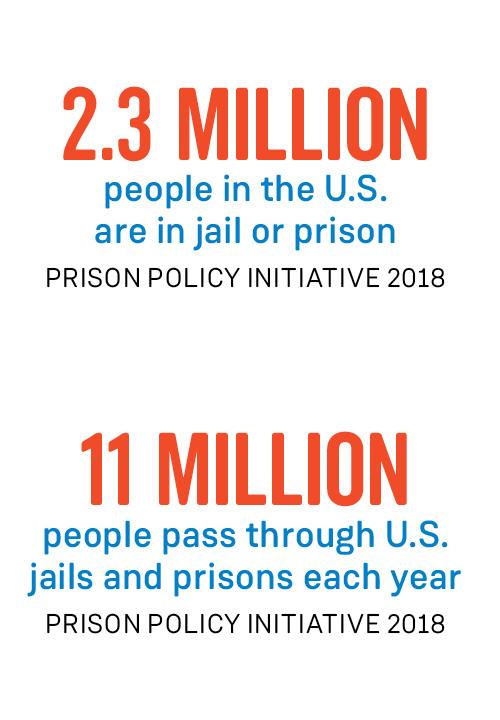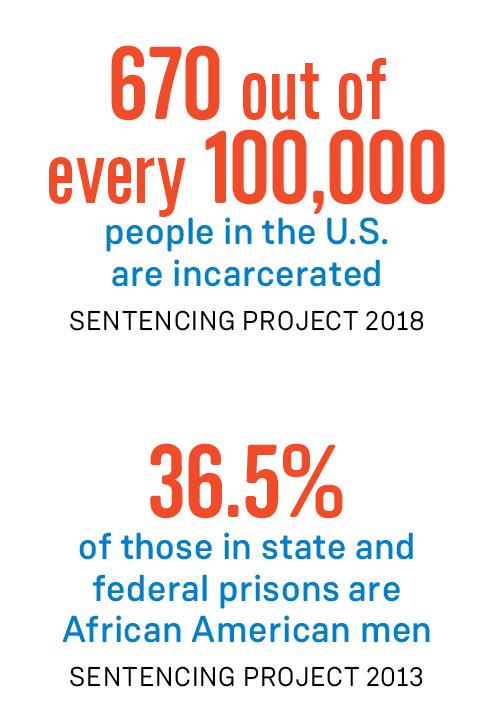
“The degree of civilization in a society
can be judged by entering its prisons.”
—Fyodor Dostoyevsky
This quote from the famous classic Russian novelist of the 1800s can easily be adapted to hepatitis C in the United States today: “The degree of the U.S. commitment to hepatitis C elimination can be judged by its commitment to treating HCV in prisons.”
Hepatitis C (HCV) and prisons go hand in hand. The U.S. has the largest population of inmates in the world, with over 2.3 million men, women and transgender persons in jail or prison on any given day (see Box 1). With around 1.5 million people in prisons, the overall HCV prevalence (people infected with HCV) in prisons around 18% (with states ranging from approximately 10% to 41%), estimates of the number of people in prison living with HCV can vary, with 270,000 as the generally accepted number, with some thinking it could be over 500,000. Specific jail numbers are hard to come by, as most jail systems do not screen for HCV or have available data, but it is safe to assume that the percentages in jail are roughly the same as they are in prisons. It’s estimated that one-third, or 30%, of people with hepatitis C pass through the criminal justice system each year.

Hepatitis C (HCV) and prisons go hand in hand. The U.S. has the largest population of inmates in the world, with over 2.3 million men, women and transgender persons in jail or prison on any given day (see Box 1). With around 1.5 million people in prisons, the overall HCV prevalence (people infected with HCV) in prisons around 18% (with states ranging from approximately 10% to 41%), estimates of the number of people in prison living with HCV can vary, with 270,000 as the generally accepted number, with some thinking it could be over 500,000. Specific jail numbers are hard to come by, as most jail systems do not screen for HCV or have available data, but it is safe to assume that the percentages in jail are roughly the same as they are in prisons. It’s estimated that one-third, or 30%, of people with hepatitis C pass through the criminal justice system each year.
Of the 2.3 million in jail or prison, it’s important to keep in mind that most will be released: 95% of state prisoners will return to society. People in jail are typically incarcerated for shorter stays, either awaiting trial or serving sentences for less than a year, with an average stay of 2–5 days. Over 11 million people pass though jail or prison each year in the U.S.
People in prison often have other medical and mental health issues, as well as high rates of drug use and addiction. The sheer numbers of people who pass through the criminal justice system, combined with their high rates of HCV, make prisons an ideal location for preventing, testing, and treating HCV, helping put the U.S. on track to eliminate HCV by 2030 per World Health Organization goal. (A caveat: The best way to keep people who use drugs healthy is to not put them in prison in the first place, but provide them with medical care, harm reduction, and social services on the outside rather than arrest them and put them away.)

Myth #1:
Prisoners are not worthy of HCV treatment
This argument is sometimes stated outright, but more often than not, it’s a quiet assumption that policymakers, prison officials, and the general public have but won’t say out loud.
Ironically, people in prisons are the only group in the U.S. who have a constitutional right to healthcare. In a landmark Supreme Court case, Estelle v. Gamble, it was ruled that ignoring or denying medical care to an inmate was the equivalent of cruel and unusual punishment. As the ACLU summarizes: “an inmate must rely on prison authorities to treat his [or her] medical needs; if the authorities fail to do so, those needs will not be met. In the worst cases, such a failure may actually produce physical torture or a lingering death.”
Beyond the legal rationale for treating HCV in prison, we have a moral one, too: The separation from free society and loss of liberty is the punishment for whatever crime they have been convicted of, and the removal of access to healthcare should not be included in this punishment. A person in prison should have the same rights to access healthcare as she/he would have on the outside.
Myth #2
We need to focus our treatment efforts on people who aren’t in prison
Technically, this isn’t a myth: Yes, we do need to get people who aren’t in prison treated for HCV. We also need to treat people who are in prison. It doesn’t have to be one versus the other. We can and should do both.
Guidelines, established by the American Association for the Study of Liver Diseases and the Infectious Diseases Society of America, do not distinguish who should be treated based on whether or not they are incarcerated: “Treatment is recommended for all patients with chronic HCV infection, except those with a short life expectancy that cannot be remediated by HCV therapy, liver transplantation, or another directed therapy.” A recent addition to these guidelines makes clear that people in prison should receive HCV testing, harm reduction and prevention education and support, and linkage to care and treatment, just as people who are not in prison receive.
In order to eliminate HCV, a concerted effort must be made to screen and treat HCV for all those at risk of infection, both those in and out of prisons.
Myth #3
Prisoners won’t manage their HCV properly
This is a myth based on old HCV regimens—pegylated interferon and ribavirin—that were very difficult to take. The treatment combination was very long, lasting 48 weeks, required an injection once per week, and had severe side effects. Active drug use, co-occurring medical or mental health illness, side effects, and length of treatment all posed significant barriers to treating HCV in prisons and jails. That said, even in the days of interferon, people in prison who received treatment were cured at rates similar to those on the outside.
In today’s HCV treatment landscape, newer medications known as direct-acting antivirals (DAAs) have a shorter treatment duration (8–12 weeks), have fewer side effects, and have a cure rate of over 95%. They are safe and effective for people in prison to take, and the shorter durations make them ideal for people in jail to take as well. There is no medical or clinical reason to deny treatment to people in jails or prisons.
Myth #4
Inmates will get reinfected
This one is a little more complicated: People living in prison are at greater risk of HCV reinfection, both inside prison walls and upon release, but that’s mainly because they do not have access to all the things that we know can reduce reinfection. All the risks that exist outside of prison—sharing injection equipment and condomless anal sex—also happen within prison walls. The major difference is that people in prisons have no access to sterile syringes and injection equipment or other harm reduction services. In the U.S., there are no prisons or jails that offer syringe exchange services and safe injection supplies, none that offer safer tattooing options, and very few that offer medication-assisted therapy. Related to myths 1 and 2, there are few options for HCV treatment, and the more people who get treated in prisons and jails, the less likely reinfection will occur.
Myth #5
It’s too expensive to treat people in prison
This is the same myth we’ve heard since the DAAs were first used in late 2013. It is true that HCV treatment can be expensive. The high cost of prescription drugs in the U.S. is a problem beyond HCV, but HCV drugs have attracted some of the most media attention, as well as the attention of insurance carriers, both private and public, including prisons.
That said, the days of the $1,000 pill are well behind us. With several medications on the market and competition, as well as lower negotiated drug prices among several pharmaceutical companies and insurance carriers, both public and private, the cost of medications has dropped dramatically.
At current prices, HCV treatment is cost-effective. It is true that there will be an initial jump in spending to pay for the testing and treatment of people in prison, but this short-term cost is more than made up for in the reduction of new infections, prevention of advanced liver disease such as cirrhosis, liver cancer, or liver failure, and a reduction in HCV liver-related deaths. Patients with HCV who are cured have improved quality of life and utilize fewer health resources. Finally, when prisoners are cured inside of prison, there are benefits to the larger community, as there would be fewer new infections there too, and less cost for medical care upon release.
Beyond the myths: Doing what’s right
Anne Spaulding and colleagues from the Rollins School of Public Health, Emory University, have suggested an “opt-out” model of HCV screening in U.S. jails. An opt-out system automatically includes a test among a battery of routine tests done with a general consent, while still allowing a person to refuse the test. In a brief model put forth in the New England Journal of Medicine, Spaulding states that if there are 1 million people with HCV in jails, and 70% are offered an HCV test and 70% of those accept the offer, then 500,000 new HCV infections can be uncovered in the first year alone (Spaulding 2012). The public health impact of jail screening can have wide-ranging impacts on the health of the community as a whole.
Once new HCV infections have been identified in correctional settings, the need for support, education, care, and treatment is the responsibility of the system, as referenced above. Hepatitis C care and treatment in the DAA era is easier than ever, but it can still be very complicated and may require the work of specialists who may not be readily available in a correctional setting.
That said, successful treatment of people in corrections is possible. Today’s HCV treatments are shorter, easier to take with fewer side effects, and more effective in curing people. This not only increases the options for successful treatment of people in prison, but it also opens the door for people serving shorter sentences in jails.
Primary care providers will play a central role in treating HCV, in both community and in correctional settings, but they will need support and training to do so. To address this need, the University of New Mexico (UNM) initiated “The Extension for Community Healthcare Outcomes” (Project ECHO) to train and improve the capacity of primary care providers in rural areas and prisons to manage HCV. They employ telehealth technology, case-based training, and ongoing training to medical providers. This evidence-based model has been shown to improve the care and treatment, and consequently the cure rates, of patients in correctional settings, and the expansion of this model can serve the treatment needs of people in jails and prisons across the country.
In addition to supporting the training of medical providers, there is a strong need to provide patient support and education in jails and prisons. Peer support models have been shown to be effective interventions for patient support. The Centerforce peer health model, “Peer Health Education Program (PHEP),” was identified by the CDC in 2009 as a model program in HCV service delivery in prison settings. PHEP develops a variety of educational materials, presentations, and training, as well as videos and support group guides to HCV prevention and care. They train peer educators to hold workshops, provide one-on-one counseling, and outreach to prisoners to raise awareness. Similarly, the New Mexico Department of Corrections partners with UNM’s Project ECHO and uses telehealth to train and develop peer educators to both provide health education and support for people living with HCV, but also to prepare for a career as a community health educator upon release from prison.
Soon, we’ll have a real-world example of the impact of treating all people in prison for HCV. California has embarked on such a program. The state’s 2018 budget allocates $105.8 million per year for three years to pay for treatment of all HCV-infected prisoners in the state. In the first year, they will focus on treating the sickest inmates—those with advanced liver scarring and cirrhosis—while scaling up their treatment programs and capacity. In years two and three, all remaining HCV-infected inmates will be treated and cured, with ongoing screening and monitoring for new infections, reinfections, and other liver-related medical issues.
Conclusions
Ideally, the U.S. would not have the world’s largest prison system with epidemic levels of HCV, and have a society where we are able to screen, care for, and treat HCV patients before they enter prison. Until then, we are legally and morally obligated to take care of prisoners’ HCV screening, prevention, and treatment needs. With new testing technologies, improved treatment regimens, and innovative, evidence-based harm reduction interventions, we have the means at our disposal. We need to dispel the myths that serve as barriers to HCV care and treatment behind bars, and shift both public policy and political will that will lead to dramatic implications for both prison and public health. As researchers state: …”we can help to change the perception of the HCV epidemic in the criminal justice system, transforming it from a legal liability to a critical opportunity to change the course of HCV in the United States.”
Andrew Reynolds, who compiles the POSITIVELY AWARE and Project Inform Annual Hepatitis B and C Drug Guide, is the Hepatitis C and Harm Reduction Manager at Project Inform, and facilitates several HCV support groups in the San Francisco Bay Area.
Social policy decisions can have far-reaching effects and unintended consequences. Rather than taking a public health approach to address illegal drug use, the U.S. chose to deal with the issue by declaring a “war on drugs” that began in the 1970s. In choosing to incarcerate drug users rather than provide drug treatment and other harm reduction interventions, arrest rates soared, and the U.S. prison population exploded in the decades to follow.
- Injection drug use is the most common mode of HCV transmission, accounting for approximately 70% of new infections. People who inject drugs (PWID) are also arrested and incarcerated at rates well above the average.
- Initiated by President Richard Nixon, the war on drugs is now nearly 50 years old, and has not resulted in reductions in drug use, but rather, increased our country’s prison population, disproportionately targeted people of color (especially African Americans) and widened health disparities in infectious diseases like HIV and HCV.
- A public health approach, where we decriminalize personal drug use, expand harm reduction programs like syringe access services and safe consumption spaces, and replace incarceration with drug treatment and medication-assisted therapy, would be a far more effective approach to drug use.
Most inmates with HCV enter jails or prisons already infected with the disease, but there are a number of risk factors that, when combined with the closed setting and poor access to drug treatment and harm reduction services, may exacerbate risk and lead to new infections among previously HCV-negative persons.
These risk factors include the following:
- Sharing of syringes and other injecting equipment
- Sharing of intranasal snorting equipment (straws, Visine bottles) for non-injectable drugs
- Limited access to drug treatment, including medication-assisted therapy
- Limited access to HCV treatment (treatment as prevention)
- Unsterile tattooing and piercing
- Condomless sex among inmates living with HIV (HIV-positive individuals are at greater risk of sexual transmission of HCV)
Although needle and syringe access programs (SAPs) remain a controversial issue in many parts of the U.S., it is well established that these programs are an effective, evidence-based intervention for preventing HIV and HCV infections in people who inject drugs (PWIDs). If PWIDs are incarcerated, they then no longer have access to these prevention tools. Internationally, however, prison and public health officials have introduced prison-based needle exchange programs that have had similar benefits as they do on the outside. Over 60 prisons in 10 countries operate SAPs in prisons; research and evaluation of these programs have found that needle-sharing is decreased, HIV infections are reduced, and there was no increased injection drug use or increases in levels of drug use. In over 30 years of operation, there have been no reports of syringes used as weapons.


